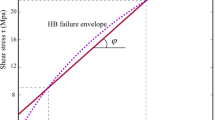Abstract
The stability of a residual soil slope is a system of grey and white, and gradual change and sudden change. It is difficult to accurately forecast the instability time of a granite residual soil slope, because the factors affecting the instability of granite residual soil slopes are random and uncontrollable. Using the grey prediction method, the accumulation generation of data weakens the influence of random disturbance factors in the original sequence, and enhances the regularity of data. In this paper, we proposed a grey cusp catastrophe prediction model to calculate the instability time of granite residual soil slopes under rainfall. We took one-time cumulative transformation of the remote monitoring data of slope displacement, and then conducted polynomial regression fitting on the processed displacement data and monitoring time. The grey cusp catastrophe instability prediction model of granite residual soil slopes was established using the nonlinear dynamic catastrophic prediction theory. The critical instability time of the slope was predicted using the grey catastrophe instability prediction method presented in this paper. For comparison, we conducted exponential curve fitting on the displacement data and monitoring time, and then established the Saito instability forecasting method of a soil slope to predict the slope instability. Through the engineering application, and using the presented grey catastrophe slope instability prediction method, the slope instability process may be accurately predicted. The calculation results using the grey catastrophe slope instability prediction method presented in this paper are in good agreement with the actual situation. Whether it can be used for other slopes remains to be further studied.








Similar content being viewed by others
References
Ahangar-Asr A, Faramarzi A, Javadi AA (2010) A new approach for prediction of the stability of soil and rock slopes. Eng Comput 27(7–8):878–893
Cubitt JM, Shaw B (1976) Geological implications of steady-state mechanisms in catastrophe theory. J Int Assoc Math Geol 8(6):657–662
Ge H, Tu J (2011) Nonlinear coupled model for predicting slope displacement and its application. Rock Soil Mech 32(6):1808–1812
Henley S (1976) Catastrophe theory models in geology. J Int Assoc Math Geol 8(6):649–655
Long H, Qin SQ, Wan ZQ (2002) Catastrophe analysis of rainfall-induced landslides. Chin J Rock Mech Eng 21(4):502–508
Miao SJ, Hao X, Guo XL, Wang ZM, Liang MC (2017) Displacement and landslide forecast based on an improved version of Saito's method together with the Verhulst-Grey model. Arab J Geosci 10(3). https://doi.org/10.1007/s12517-017-2838-y
Mukhlisin M, Taha MR (2012) Numerical model of antecedent rainfall effect on slope stability at a hillslope of weathered granitic soil formation. J Geol Soc India 79(5):525–531
Osanai N, Shimizu T, Kuramoto K, Kojima S, Noro T (2010) Japanese early-warning for debris flows and slope failures using rainfall indices with radial basis function network. Landslides 7(3):325–338
Saito M (1965) Forecasting the time of occurrence of a slope failure. In: Proceedings of the 6th international conference on soil mechanics and foundation engineering. Univ. of Toronto Press, Toronto, pp 537–541
Vaziri A, Moore L, Ali H (2010) Monitoring systems for warning impending failures in slopes and open pit mines. Nat Hazards 55(2):501–512
Xiong CX, Gong XN, Wang CH (2000) A deformation energy catastrophic model of high-speed land- slide before sliding. J Zhejiang Univ: Eng Sci 34(4):443–447
Zhang J, Huang HW, Zhang LM, Zhu HH, Shi B (2014) Probabilistic prediction of rainfall-induced slope failure using a mechanics-based model. Eng Geol 168(1):129–140
Acknowledgements
This work was financially supported by grants from the Yalong River Joint Fund of National Natural Science Foundation of China and Yalong River Hydropower Development Co., Ltd. (no. U1765110), the Fundamental Research Funds for the Central Universities (22120180312), the National Natural Science Foundation of China (no. 40872179), and the Natural Science Foundation of Shanghai (16ZR1423300).
Author information
Authors and Affiliations
Corresponding author
Rights and permissions
About this article
Cite this article
Xu, J., Ni, Y. Prediction of grey-catastrophe destabilization time of a granite residual soil slope under rainfall. Bull Eng Geol Environ 78, 5687–5693 (2019). https://doi.org/10.1007/s10064-019-01510-5
Received:
Accepted:
Published:
Issue Date:
DOI: https://doi.org/10.1007/s10064-019-01510-5




